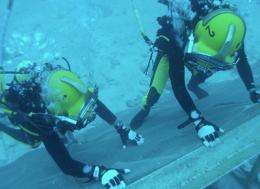Astronomer Squyres becomes NASA aquanaut

Cornell professor of astronomy Steven Squyres, the lead scientist for NASA's Rover mission to Mars, has just taken the plunge as a NASA aquanaut.
Cornell's Goldwin Smith Professor of Astronomy is one of six aquanauts who splashed down Oct. 20 for a 13-day undersea training mission off Key Largo as part of the 15th mission of the NASA Extreme Environment Mission Operations (NEEMO) program. They will perform "spacewalks" and other exercises to simulate an asteroid mission.
Squyres, the scientific principal investigator for the Mars Exploration Rover mission, and the other crew members are living in the Aquarius Undersea Laboratory Base to test techniques, operational methods, tools and communications protocols recently developed for human exploration of near-Earth asteroids (NEAs).
The 400-square-foot lab, about the size of a school bus, sits on the ocean floor at a depth of about 62 feet. The crew includes Squyres, who has some research diving experience from an expedition to Antarctica in the 1980s, four NASA crew members and two staff members of the National Undersea Research Center.
"We'll be simulating the process of doing basic field geology tasks on the surface of an asteroid, like deploying instruments and collecting samples," Squyres told the New Scientist. "We will be trying lots of ways to do it, using ropes and small one-person subs to move crew members around."
NASA has a 2025 mission planned to an asteroid that is about two-thirds of a mile in size. Squyres said that the mission will basically be in a microgravity environment.
"Nobody knows how to do field geology in microgravity -- the best way to simulate it is underwater," he said. Considering that he is 55 years of age, 10 years older than the next oldest NEEMO crewmember, he said he didn't think he'd be involved in the 2025 mission: "I think this is going to be the closest to an asteroid I'm ever going to get," he told New Scientist. "I'll be watching the asteroid mission on TV from my rocking chair."
The NEEMO science team will map and explore the coral reef around Aquarius, using operational techniques and protocols that will have a direct bearing on future human space exploration missions.
"We're using the bottom of the ocean which is a great way to simulate the conditions we would encounter at an asteroid," Squyres told keynews.com. "We will use a small sub to simulate a small space module. We will experiment with thruster packs as well."
On Oct. 26 Squyres plans to give a lecture via Skype from the habitat about asteroid exploration and NEEMO for the course, The History of Exploration: Land, Sea and Space, that he is co-teaching at Cornell with Mary Beth Norton, the Mary Donlon Professor of American History.
Provided by Cornell University



















